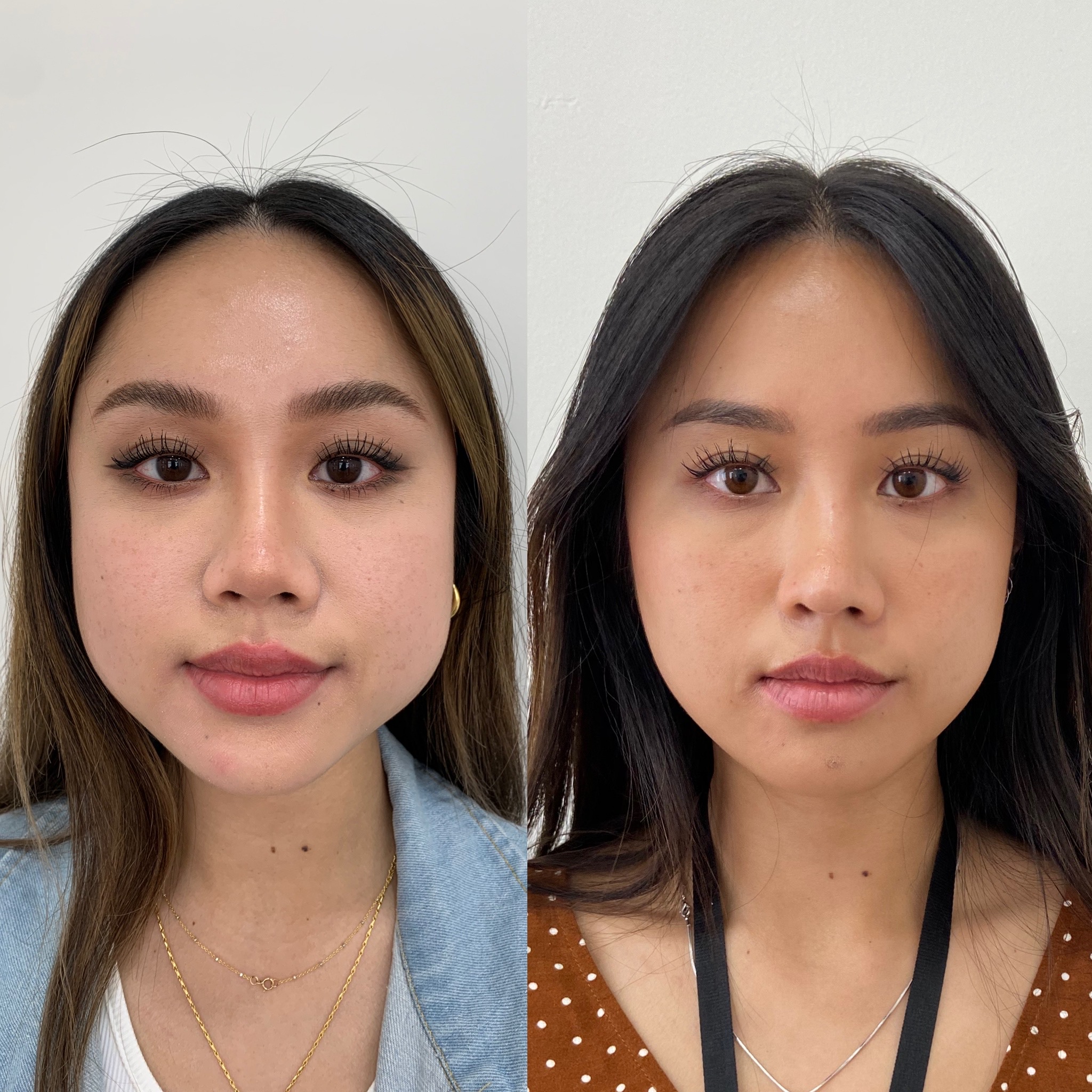Jaw Botox, also known as Masseter Botox, is becoming increasingly popular for both cosmetic and therapeutic reasons. It offers a non-surgical way to achieve a slimmer jawline and can also provide relief from TMJ pain and teeth grinding. This comprehensive guide explores the procedure, its benefits, potential downsides, costs, and what you can expect from Jaw Botox before and after treatment. Injectable fillers for the face before and after are another avenue to enhance facial features, and we encourage you to explore those as well.
Understanding Jaw Botox
What is Jaw Botox?
Botox, short for Botulinum toxin, is a purified protein injected into muscles to temporarily relax them. In the context of jawline slimming, it targets the masseter muscles, located on the sides of the jaw and responsible for chewing. When these muscles are overdeveloped, they can create a square or bulky jaw appearance. By relaxing and effectively shrinking these muscles, Botox can soften the jawline, potentially leading to a more oval or heart-shaped face. This treatment is becoming increasingly popular, with results often featured in before-and-after photos online and on platforms like TikTok (though it’s crucial to consult with a healthcare professional for personalized advice, rather than relying solely on social media trends).
Why Consider Jaw Botox?
Jaw Botox offers a range of cosmetic and therapeutic benefits:
- Slimmer Jawline: This is the primary cosmetic motivation. Botox can reduce the width of the lower face, creating a more defined and contoured appearance.
- TMJ Pain Relief: Botox can alleviate the pain and discomfort associated with temporomandibular joint (TMJ) disorders by relaxing the jaw muscles. The American Association of Oral and Maxillofacial Surgeons (AAOMS) recognizes the use of Botox for certain TMJ-related pain. We’ll delve deeper into the relationship between Botox and TMJ later.
- Reduced Teeth Grinding (Bruxism): Botox can help manage bruxism, preventing excessive wear and tear on teeth and potentially reducing associated jaw pain.
- Non-Surgical Approach: Unlike surgical jaw reduction, Botox is minimally invasive with limited downtime.
Jaw Botox: Before & After Results
One of the best ways to understand the potential of Jaw Botox is through real patient results. Before-and-after photos illustrate the noticeable slimming effects Botox can have on the jawline, demonstrating transitions from a square jaw to a more sculpted, oval or heart-shaped face. (Include a selection of diverse before-and-after photos here, with captions detailing the number of Botox units used and the time elapsed since treatment. Sourcing high-quality images from reputable clinics is crucial, ensuring patient consent and respecting privacy.)
Botox for TMJ and Teeth Grinding
Many individuals experience jaw tension, pain, and headaches associated with TMJ disorders. Bruxism, or teeth grinding, often contributes to these issues. Botox offers a potential solution by relaxing the masseter and other jaw muscles, reducing tension and potentially alleviating pain. (Incorporate patient testimonials or anecdotes if available, highlighting the positive impact of Botox on TMJ pain and teeth grinding. Share personalized stories, with patient permission, to connect with readers facing similar challenges.)
The Jaw Botox Procedure and Recovery
What Happens During the Procedure?
The Jaw Botox procedure is straightforward:
- Consultation: A qualified practitioner will assess your facial anatomy, discuss your aesthetic or therapeutic goals, and determine the appropriate Botox dosage.
- Injection: Using a fine needle, Botox is injected directly into the masseter muscle on both sides of the jaw. The number of injections depends on individual needs and desired results.
- Recovery: There is minimal downtime. Most people can return to their regular activities immediately. Mild bruising or swelling at the injection sites is possible but usually subsides within a few days.
Understanding Costs and Longevity
How much does Jaw Botox Cost?
The cost of Jaw Botox varies depending on factors like location, practitioner experience, and units required. Typically, the price ranges from $12 to $18 per unit, and between 20 and 50 units per side may be necessary. This translates to a potential total cost of $480 to $1800 per treatment. (Provide a more detailed breakdown of costs based on the number of units needed for different degrees of masseter reduction. Include examples of pricing structures or special offers, if available, such as those referenced in the LaserAway example.) Always consult with a practitioner for a personalized quote.
How Long Does Jaw Botox Last?
Jaw Botox results typically last between three to six months. Factors like metabolism, dosage, and muscle activity can influence the duration. Regular treatments every three to six months can help maintain the desired effects.
Jaw Botox vs. Other Options
Botox offers a non-surgical route to jaw slimming and TMJ relief. However, other options exist:
| Treatment | Description | Pros | Cons |
|---|---|---|---|
| Jaw Botox | Botox injections to relax jaw muscles. | Non-surgical, quick recovery, noticeable results. | Temporary, requires maintenance, potential side effects. |
| Jaw Reduction Surgery | Surgical reshaping of the jawbone. | Permanent, dramatic changes. | Invasive, longer recovery, higher cost, potential complications. |
| Mouthguards | Worn to prevent teeth grinding. | Protects teeth, may alleviate TMJ pain. | Doesn’t slim the jaw, can be uncomfortable. |
| Physical Therapy | Exercises and stretches to improve jaw mobility and reduce pain. | Non-invasive, addresses underlying issues. | May not be effective for all, requires consistent effort. |
Potential Downsides of Masseter Botox
While generally safe, Masseter Botox has potential side effects:
- Common: Bruising, swelling, soreness at the injection site, temporary muscle weakness, slight asymmetry.
- Less Common: Difficulty chewing or talking, allergic reactions.
- Rare: Excessive sweating, dry mouth, spreading pain.
The long-term effects of repeated injections are still under investigation. Some experts suggest the possibility of muscle atrophy with prolonged use. It’s essential to discuss your medical history and any concerns with your practitioner.
Choosing the Right Professional
Consulting a board-certified dermatologist or plastic surgeon experienced in facial injectables is paramount. They can tailor a treatment plan to your unique needs, ensuring optimal and safe outcomes. Don’t hesitate to ask questions and view before-and-after photos from their previous patients.
Conclusion
Jaw Botox offers a non-surgical approach to achieving a slimmer jawline and relieving TMJ-related pain. While results are temporary, requiring maintenance treatments, the procedure is generally safe and effective when performed by a qualified professional. By exploring before-and-after photos and consulting with an expert, you can make an informed decision about whether Jaw Botox is the right choice for you.
- Weight Loss Supplements That Work and Those That Dont - October 31, 2025
- Male Eating Disorders Often Missed but Increasingly Prevalent - October 29, 2025
- Males With Anorexia Nervosa Have Distinct Symptoms and Treatment Needs - October 28, 2025










